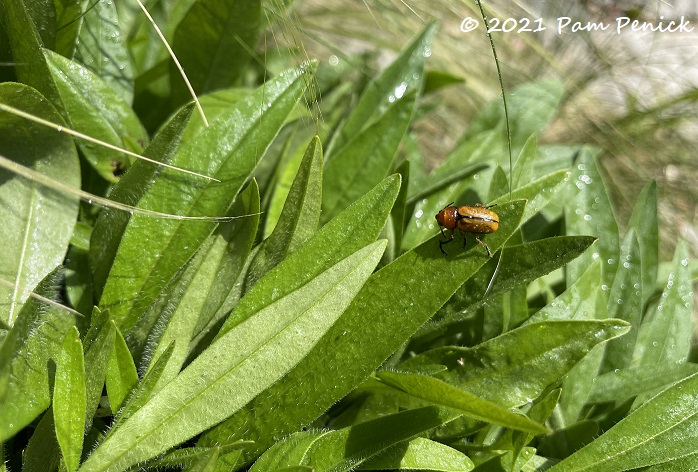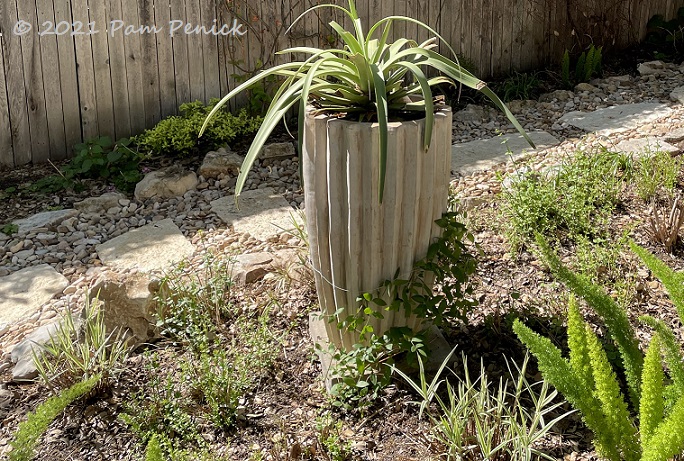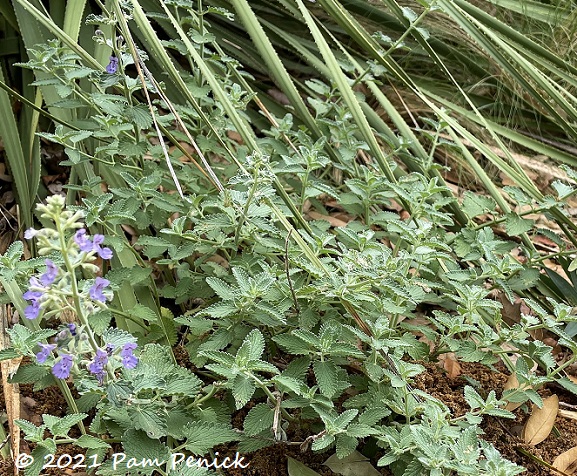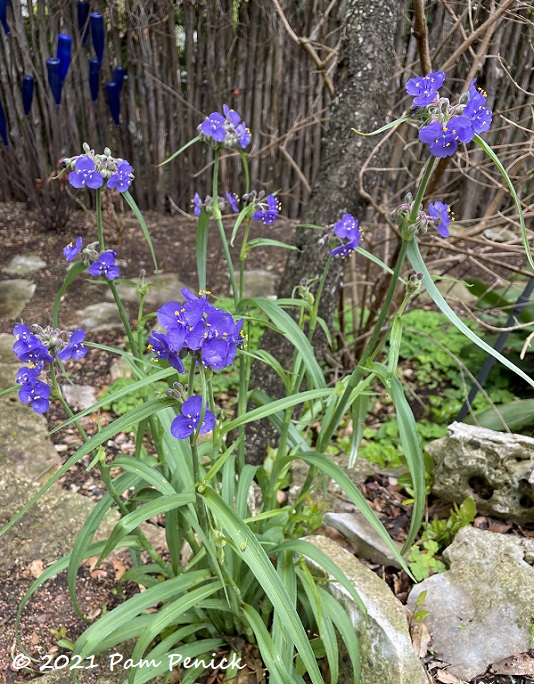My perennials: Alive, dead or in-between? Evaluating plants 2 months after Texas freeze

Today I’m taking a look at my perennials, the second largest plant group in my garden, and one that happily suffered little lasting damage from the freeze! But first, the backstory.
Texas gardeners are feverishly comparing notes about plant survivors and croakers after February’s Big Freeze. I’m doing the same and documenting how every plant in my garden fared. Please see my first post in this series for the introduction and for notes about my trees.
Asterisks indicate plants native to Texas. Plants that were stunted, maimed, or killed by the freeze are in bold, for easier searching.

Perennials
- Achillea ‘Moonshine’ – ‘Moonshine’ yarrow: Completely unfazed.
- Artemisia vulgaris ‘Oriental Limelight’: Died to the ground as usual and is coming back.
- Asparagus retrofractus – Ming fern: Killed.
- Aspidistra elatior – Cast-iron plant: Some leaves are bleached and are floppy, but it’s otherwise OK. This is a good time of year to cut it to the ground if you need to rejuvenate a damaged or tired-looking plant.
- Aster oblongifolius – Fall aster*: Completely unfazed.
- Barleria cristata – Philippine violet: Killed to the roots but is slowly coming back.
- Capsicum annuum – Chile pequin*: Died to the ground as usual and is slowly coming back.
- Caryopteris x clandonensis ‘Beyond Midnight’ – Bluebeard, or blue spirea: Died to the ground as usual and is coming back quickly.
- Chrysanthemum ‘Country Girl’ – ‘Country Girl’ mum: Completely unfazed.
- Conoclinium greggii – Gregg’s mistflower*: Died to the ground as usual and is coming back quickly.
- Coreopsis lanceolata ‘Sterntaler’ – Lanceleaf coreopsis, or tickseed*: Completely unfazed.
- Cuphea ‘Twinkle Pink’: Died to the ground as usual and is coming back slowly.
- Echeandia texensis – Copper spiders, Texas craglily, or Texas shooting star*: Died to the ground as expected (it’s a new plant as of last fall) and is coming back quickly.
- Echinacea purpurea – Purple coneflower*: Completely unfazed and is starting to bloom.
- Farfugium japonicum ‘Gigantea’ – Giant leopard plant: Collapsed in a mushy heap of melted leaves. I cut them to the ground, and the plant swiftly rebounded. In a matter of weeks it was full and lush again.
- Gaillardia aestivalis ‘Glitz ‘n Glamour’ – ‘Glitz ‘n Glamour’ blanketflower*: Completely unfazed.
- Gaura lindheimeri ‘Karalee Petite Pink’ – Whirling butterflies: Died to the ground as usual and is coming back quickly.
- Gomphrena ‘Little Grapes’: Died to the ground as usual and is coming back quickly.
- Hemerocallis – Daylily: ‘Wilson’s Yellow’, ‘Apple Tart’, ‘Best of Friends’: Completely unfazed.
- Hibiscus calyphyllus – Lemon yellow rosemallow: Died to the ground and is returning quickly.
- Lantana montevidensis – Purple trailing lantana: Killed in a container left outside.
- Melampodium leucanthum – Blackfoot daisy*: Killed but is short-lived anyway, and I don’t blame the freeze.
- Monarda fistulosa ‘Peter’s Purple’ – ‘Peter’s Purple’ bee balm*: Coming up from the roots as expected, but I have less of this plant than in years past. I don’t know if that’s due to the freeze or something else.
- Nepeta ‘Cat’s Pajamas’ – ‘Cat’s Pajamas’ catmint: Completely unfazed and blooming.

- Nepeta x faassenii (syn. Nepeta racemosa) – Catmint: Completely unfazed and blooming.
- Penstemon tenuis – Gulf Coast penstemon*: Completely unfazed and blooming.
- Plumbago auriculata – Plumbago, dark blue and white: Killed to the roots but slowly coming back.
- Russelia equisetiformis – Firecracker fern: During the freeze the stems ruptured, forming icy ribbons like frostweed does. The plant died to the ground but is coming back quickly.
- Russelia rotundifolia – Round-leaf firecracker fern: During the freeze the stems ruptured, forming icy ribbons like frostweed does. The plant died to the ground but is coming back quickly.
- Russelia x St. Elmo’s Fire: During the freeze the stems ruptured, forming icy ribbons like frostweed does. The plant died to the ground but is coming back quickly.
- Salvia ‘Amistad’: Died to the ground and is returning slowly.
- Salvia farinacea ‘Midnight Candle’ – ‘Midnight Candle’ mealy blue sage*: Half of my year-old plants were killed (even with sheet protection during the freeze), but the remaining ones are rebounding from the roots and starting to bloom.
- Salvia madrensis – Forsythia sage: Died to the roots, and I worried I’d lose this native-Mexico plant. But it’s coming back from the roots and growing well.
- Salvia officinalis ‘Purpurascens’ – Purple sage: Completely unfazed.
- Stachys coccinea – Texas betony*: Died to the ground and is coming back slowly.
- Tagetes lucida – Mexican mint marigold: Died to the ground and is coming back from the roots.
- Talinum paniculatum ‘Limon’ – ‘Limon’ Jewels of Opar: I just sowed seeds last fall, and the new seedlings are plentiful (ha!) and healthy.
- Thelypteris kunthii – River fern*: Died to the ground and is returning quickly.

- Tradescantia occidentalis – Spiderwort*: Completely unfazed and has been flowering well.
- Tulbaghia violacea ‘Variegata’ – Variegated society garlic: Died to the ground and is returning quickly.
- Verbena bonariensis – Tall verbena: This is sometimes perennial, sometimes an annual. This year it was an annual, but seedlings have come up plentifully.
- Wedelia texana – Zexmenia*: Died to the ground and is coming back slowly.
Up next are Woody Lilies (agaves, yuccas, mangaves, etc.) and Bromeliads (dyckia). Click for my earlier posts about:
__________________________
Digging Deeper
Come learn about gardening and design at Garden Spark! I organize in-person talks by inspiring designers, landscape architects, authors, and gardeners a few times a year in Austin. These are limited-attendance events that sell out quickly, so join the Garden Spark email list to be notified in advance; simply click this link and ask to be added. Season 8 kicks off in fall 2024. Stay tuned for more info!
All material © 2025 by Pam Penick for Digging. Unauthorized reproduction prohibited.


I gardened in Colorado for many years before returning to Austin. There was a reason gardens there are dominated by herbaceous perennials.
The next post on woody lilies is going to be the heart-breaker.
Good point about Colorado and cold-climate gardening. As for the woody lilies, yes, there were some big losses there. But for me the shrub/palm losses have been much tougher. There are more of them, for one, and they provide so much evergreen screening and backbone in my garden. The woody lilies are dramatic punctuation marks and focal points, and as such are more easily replaced.
That makes sense. I’m glad the hollies survived as those anchor a lot of our garden.
I’m glad to see that your perennials did so well in general, Pam.
Me too, Kris. Not everything was hit hard by the freeze.
Thanks for all the info, Pam! I am just south of Austin, noting very similar results from our deep freeze.
I’m sorry you lost your purple trailing lantana in containers; mine that are planted in the ground are coming back nicely – that bit of added protection made the difference I guess. You’ve given me an idea to try though, as I bet they look great in a container!
It does spray out nicely and hang down from a container. 🙂 That one’s easy to replace! It’s good to know yours survived in the ground.
I’m in east Austin & had similar results with perennials. I lost my Little Grapes gomphrenas though, but am surprised by how many regular Strawberry Fields gomphrena & Fireworks gomphrena plants are coming back! Thank you so much for these the detailed posts–it helps so much to compare notes–& to hear reports about plants that I need to consider for the future!
Thanks for sharing your survivors too, Kate. Annuals and herbaceous perennials were, for the most part, the clear winners this time.